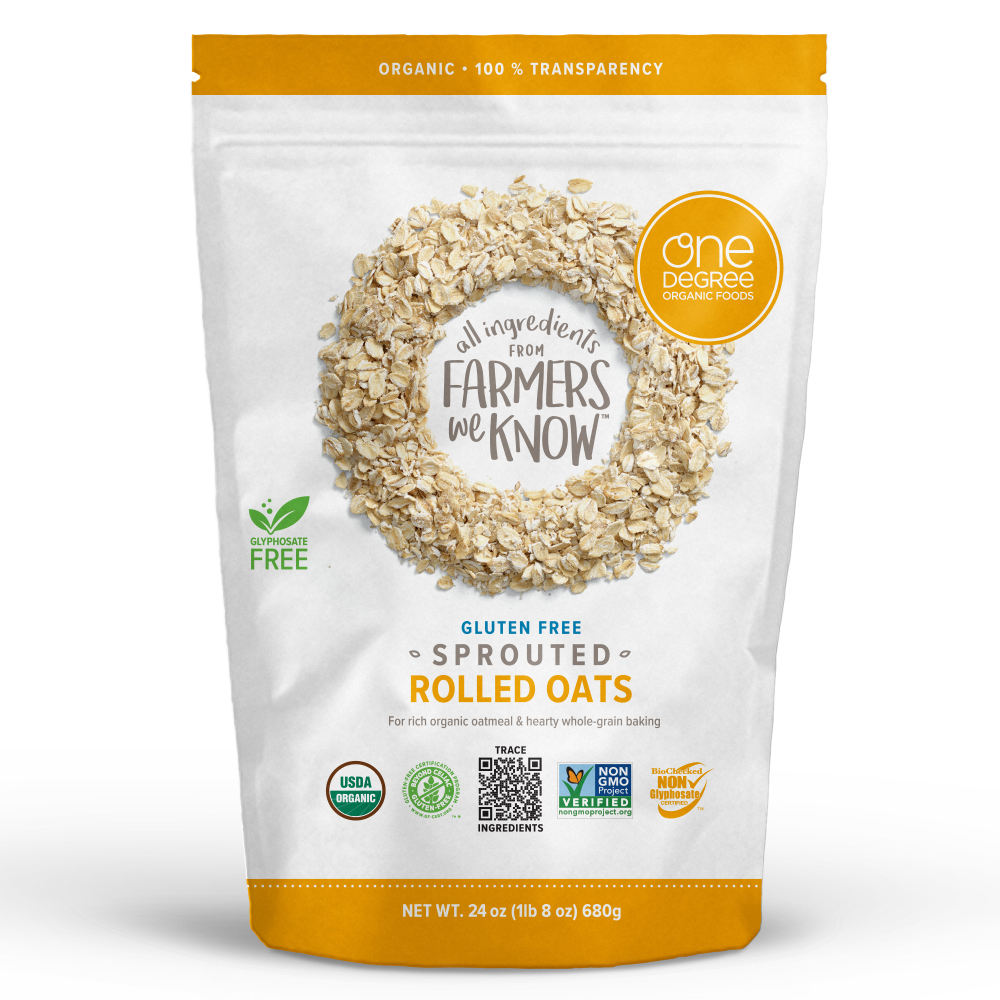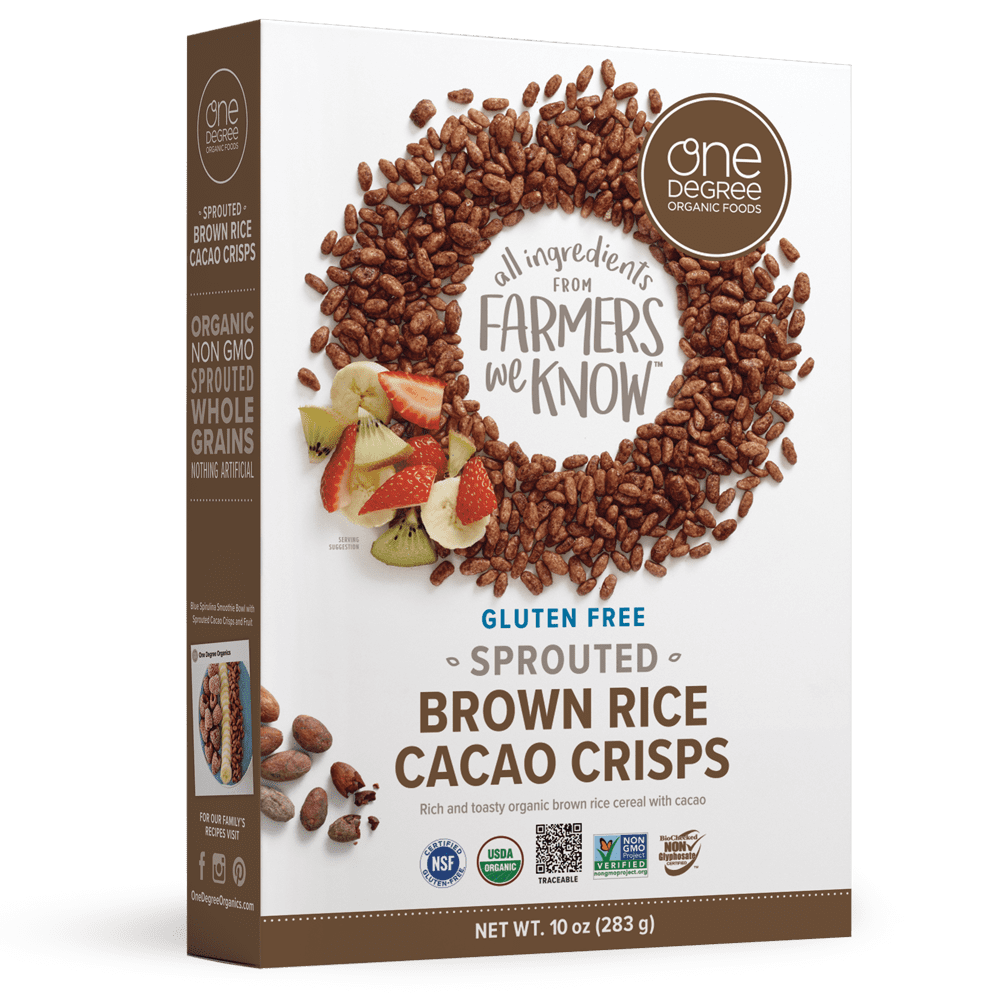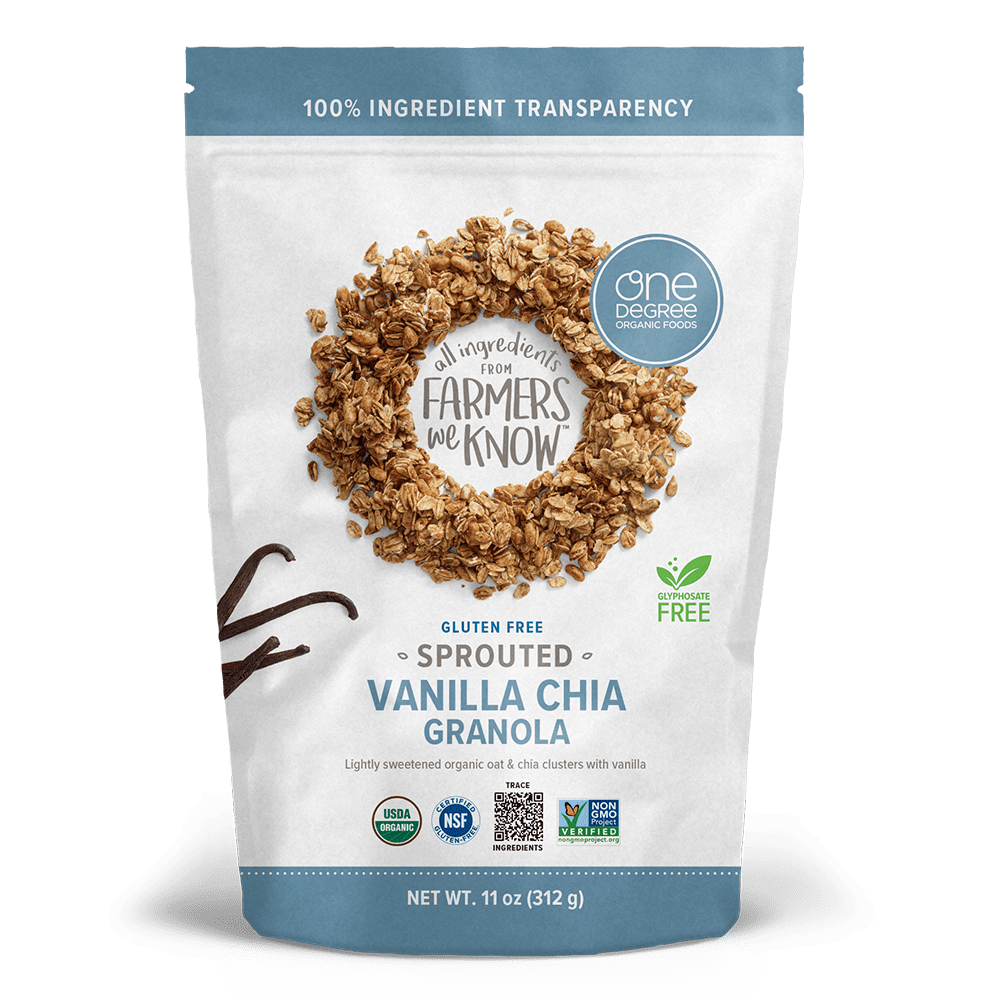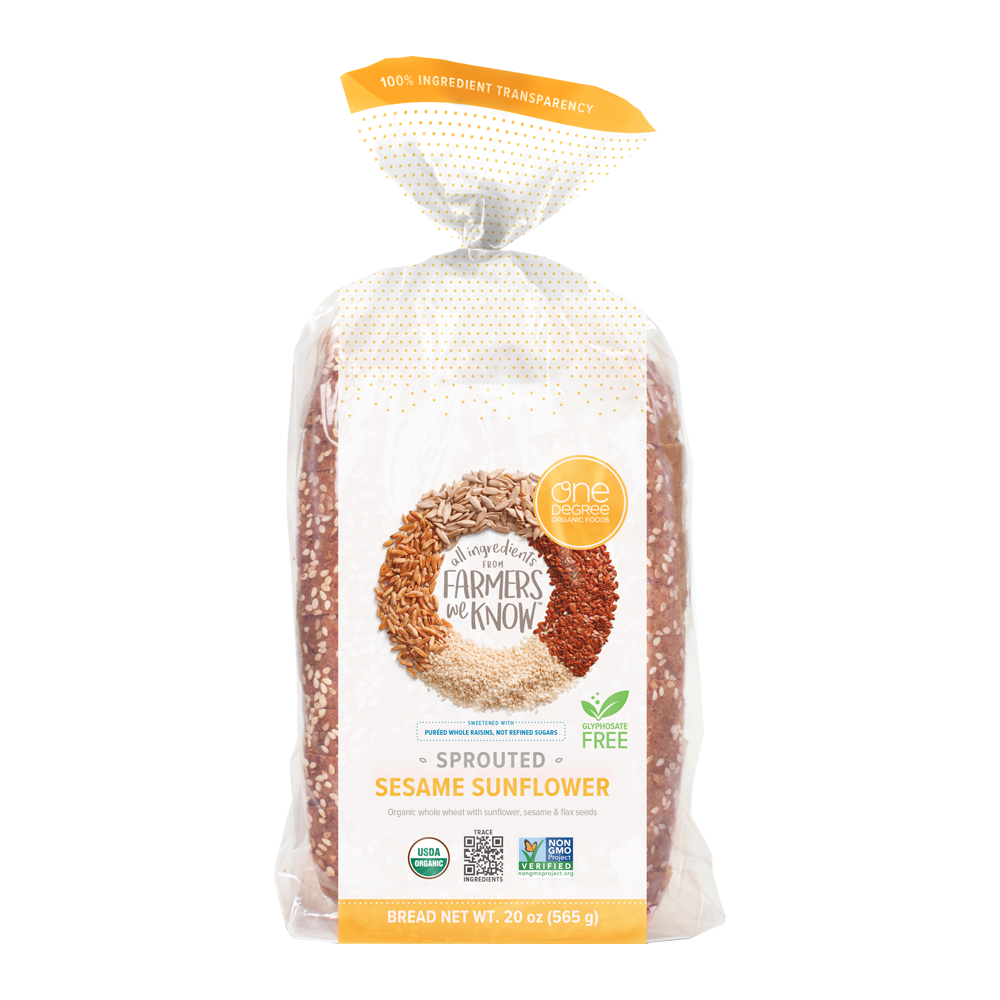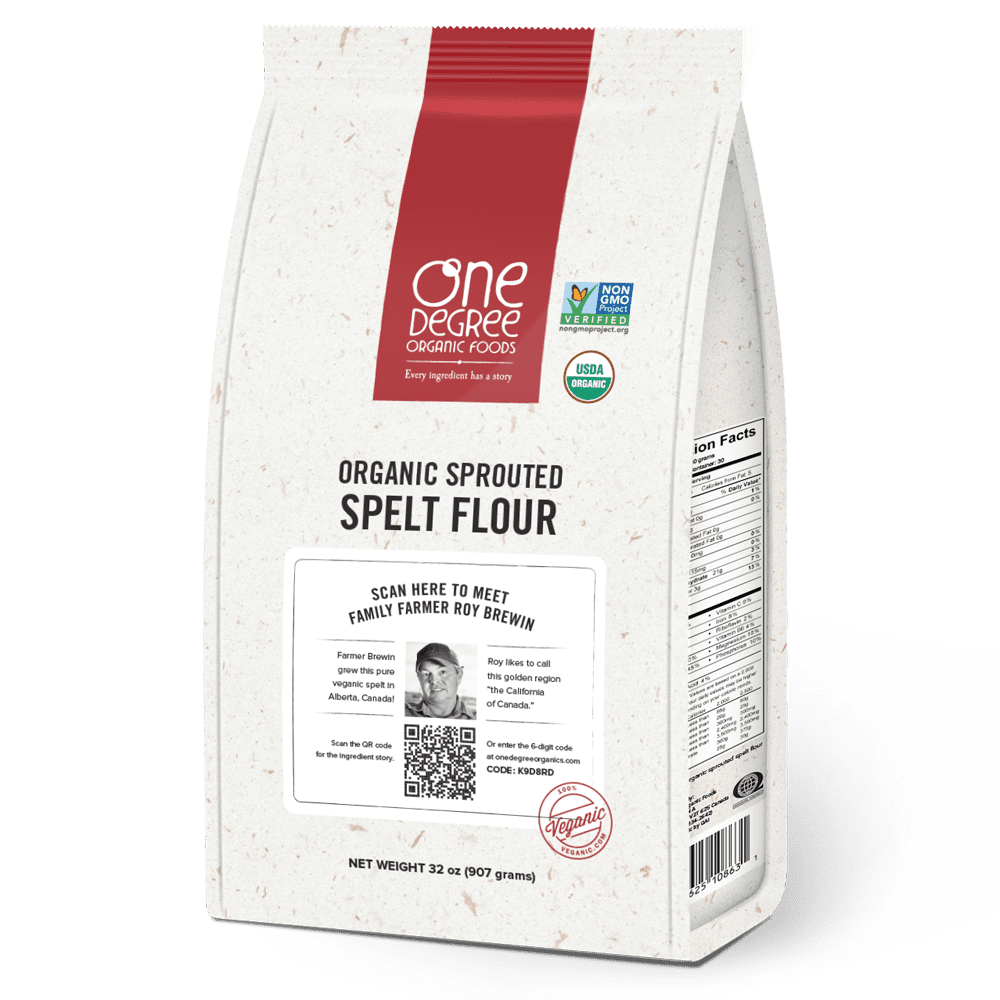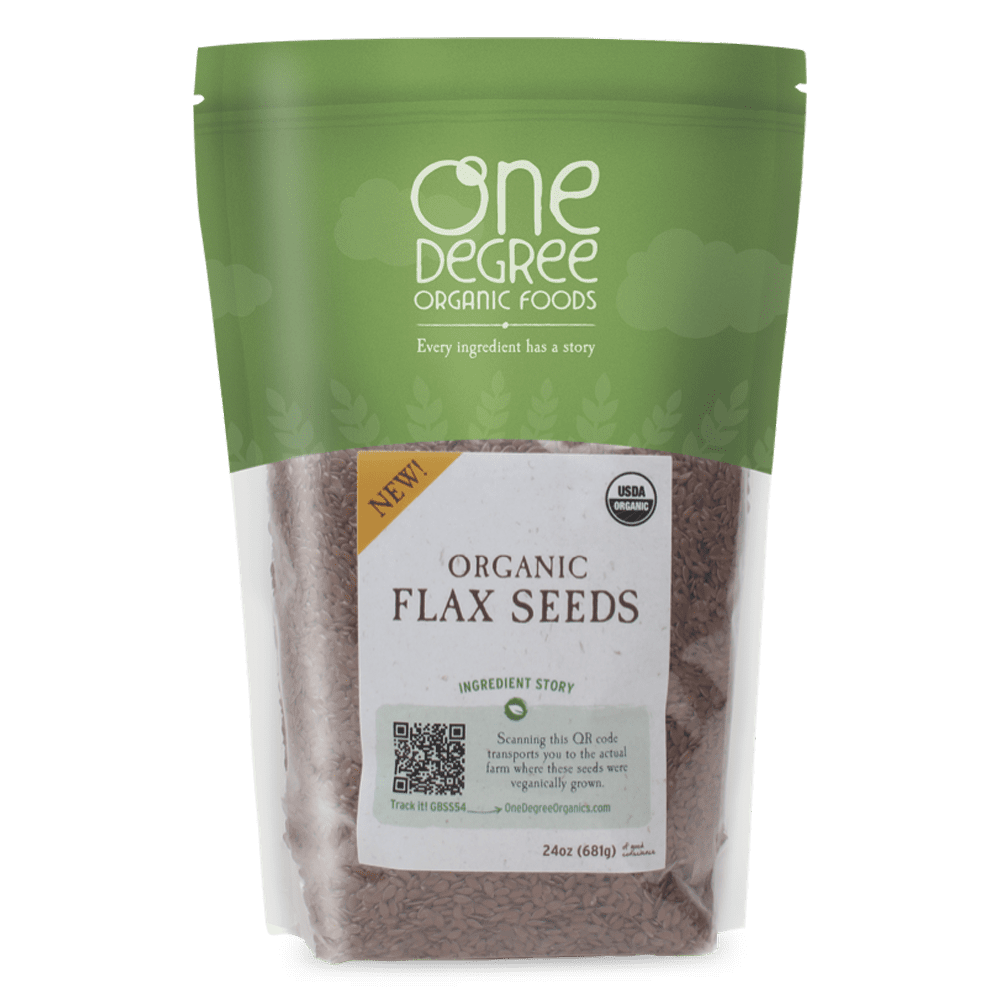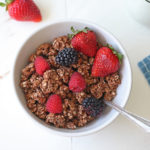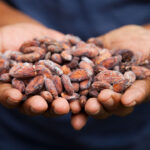The Benefits of Sprouted Flour: How to Use Sprouted Flour—and Why!
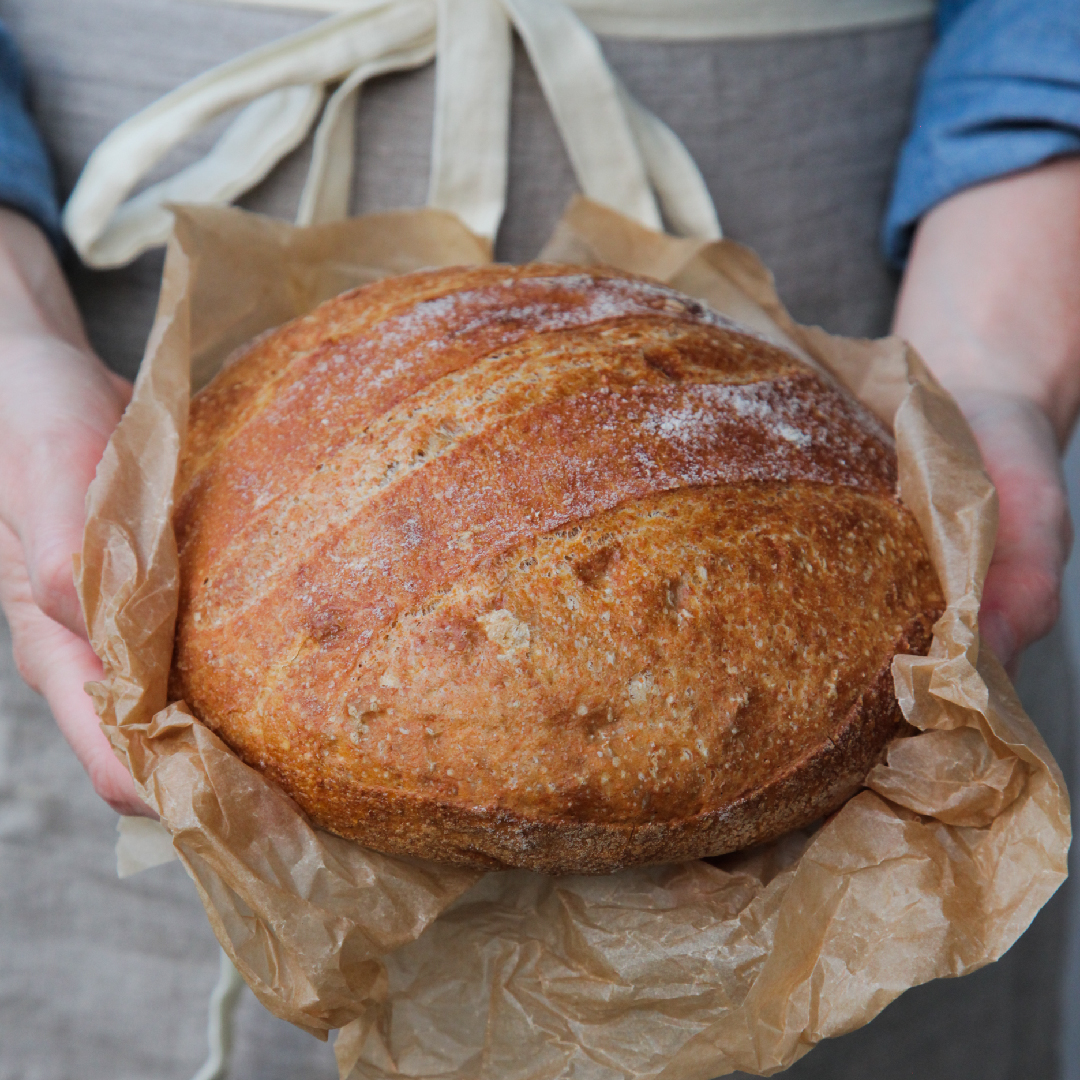
What is Sprouted Flour?
As with so many things, the simplest answer is the best. Sprouted flour is flour made from whole grains that have been sprouted to bring out all the goodness stored inside.
From wheat and spelt to gluten-free brown rice, any whole grain can be germinated and turned into sprouted flour that is ready to use in all your favorite flour-based recipes.
The Benefits of Sprouted Flour: Is Sprouted Flour Better For You?
For as long as people have been eating seeds from cereal grasses, we have known whole grains are tough to digest straight from the field. From mortar and pestles chiseled from stone to wind- and water-powered mills, millennia of human ingenuity are proof that grinding dry, hard-hulled grains into usable flour is no small effort.
People have sprouted grains at least as far back as recorded history goes. But sprouting does more than simply soften whole grains to make them easier to eat (with less work than grinding and less energy than cooking).
Sprouted whole grains are easier to digest—and you get more nutrition from them, too.
And everything you learn about the benefits of sprouted grains also applies to sprouted flour.

Why Use Sprouted Flour?
Saying that sprouted flour is better for you than regular flour is not puffery—there is a significant body of scientific research to support this claim1,2.
The natural process of sprouting activates enzymes that break down antinutrients that stand between you and the nutrition stored inside whole grains. This increases the bioavailability of vitamins and minerals, and it makes sprouted whole grains—and flour made from them—easier to digest.
Sprouted Flour Bakes Better Bread
But beyond the nutrition and digestion-enhancing benefits of sprouted flour, there are still more reasons to use sprouted flour.
After over 30 years of baking with sprouted grains and more than 10 years baking with sprouted flour, we might be biased when we say sprouted flour bakes better bread. But you don’t have to take our word for it—science says sprouted flour improves baking performance on multiple counts.
In baking and sensory studies (reviews of taste and texture), bread made from sprouted wheat flour is less bitter and has better loaf volume than bread made from unsprouted whole wheat flour3.
In a 2020 study, researchers found that bread made from sprouted whole wheat flour needs less water to form a dough with good consistency4, and that dough takes less time to develop4. In addition to a significant increase in loaf height, bread made from sprouted wheat flour has a softer, more tender crumb than bread made from unsprouted flour—and stays softer longer before staling4.
And these improvements appear not only in bread made exclusively from sprouted wheat flour, but in bread made with a mix of regular whole wheat flour and sprouted wheat flour. Recent studies show that adding as little as 2% sprouted wheat flour to bread made with ungerminated wheat flour improves loaf volume and increases the strength of the dough5.
At One Degree, we have always been motivated to sprout our grains to optimize the nutrition you get from them. But beyond the nutritional benefits, if you want to make soft, light whole grain bread that is enjoyable to bake, tastes sweeter, toasts and grills with richer flavor, and stays fresher longer4, sprouted whole grain flours are your new secret ingredient!
How is Sprouted Flour Different from Regular Flour?
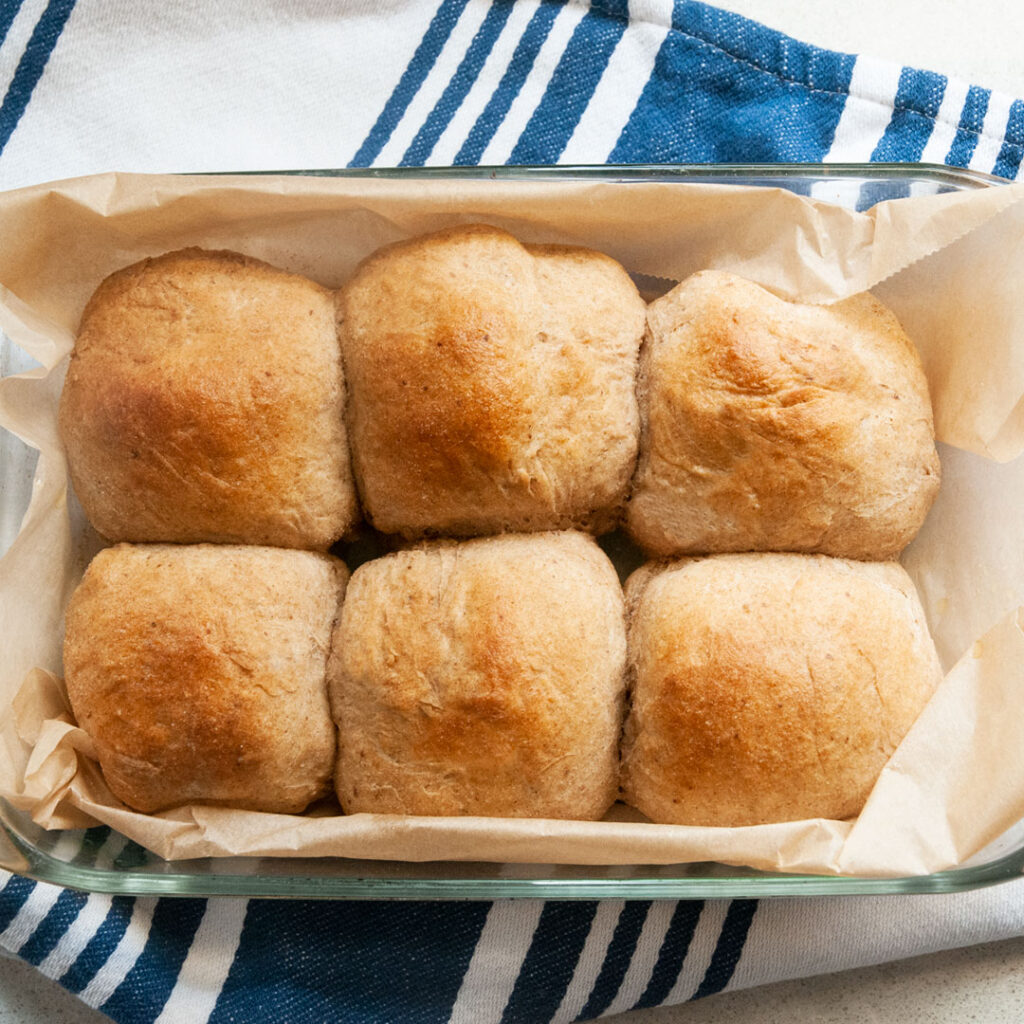
To be fair, the question of how sprouted flour is different from regular flour should only be answered using an apples-to-apples—or rather whole-grain-flours-to-whole-grain-flours—comparison. (Because regular refined flour leaves so much of the grain behind (before being fortified to add back lost nutrition), even comparing it to regular whole grain flour would be unfair).
Like regular whole grain flour, sprouted whole grain flour retains 100% of the grain’s bran and germ. Then what is the difference between sprouted flour and regular whole grain flour?
As the name suggests, sprouted flour is made from sprouted whole grain, where regular whole grain flour is made from the hard, unsprouted (or “sound”) kernels of whole grain.
Because the sprouting process softens hard whole grains like wheat, spelt, Khorasan, and brown rice, sprouted grains are easier to grind into flour—so flour made from them tends to be finer6. And that may be one more reason bakers rave about the soft, silky texture of our sprouted flours and the tenderness it brings to their recipes.
Compared to regular whole grain flour, sprouted flour has improved functional properties that go beyond how well it performs in bread. Sprouted flour has been reported to add higher elasticity to fresh pasta, and better performance in whole wheat tortillas, too7.
(And that is just what has been studied and published—our own experiences and stories from fans suggest sprouted flour performs beautifully in a full range of recipes!)
How is Sprouted Flour Made?
Whether it is sprouted or not, all whole grain flours are made using some form of mechanical process to break up the kernels and grind them into a powder. Flour can be roller milled, stone milled, or hammer milled—or produced using a combination of milling processes. And while most flours are dry ground, flour can be wet milled, too.
Different flour milling processes produce a range of textures suitable for different types of baking, from coarse semolina-style flours all the way to super fine flours perfect for pastries and cakes. Regular or sprouted, milling the perfect flours for every cooking occasion requires both technical mastery and artisanship.
No matter which grain you start with, sprouted flour starts by rinsing off the dust from field and travel so the grains are clean when they take a nice, comfortable soak in the sprouting tank.
Grains are considered sprouted when the tip of the root (the radicle) emerges from the seed for all to see. How long this takes depends on the type of grain, how dry and hard it was before soaking, and the temperature of the water (among other variables). For most of the grains we use in One Degree Organics sprouted flours, it takes up to 24 and 36 hours for the grain to tell us it is ready.
Once sprouted, the grains are gently oven dried before milling. At One Degree, we keep our drying temperature below 108 degrees F (42 degrees C). This helps retain all the raw nutrition of the sprouted whole grain while also hitting the off-switch on enzymes activated by the sprouting process that can push a grain past perfection to a shorter shelf life if not done just right.
Even after drying, softer sprouted grains take less energy and are easier to grind than unsprouted grains6—and produce a finer flour. Overall, that’s a good thing. But it also means we must take extra care in milling our sprouted grains, sometimes milling them twice to keep our flour cool as we strive for the just-right particle size.
Why does particle size matter in flour? Two reasons. First because the coarseness or fineness of a flour affects how it handles and bakes—a too-fine grind can damage the starch and limit the performance of the flour in recipes. And second because the finer the flour, the hotter it gets as it is ground. Heat increases oxidation, which can reduce the shelf life of the finished flour.
Depending on the grain, we use either hammer milling or stone milling with most of our organic sprouted flours to achieve the ideal consistency for your baking. And our team is always working on incremental improvements and new innovations to help us craft the best sprouted flour possible.
Does Sprouted Flour Taste Different?

Sprouting brings out the natural sweetness in whole grains, as the enzymes in the germinating seed break stored starch into simple sugars. That is why sprouted flour—and whatever you bake with it—tends to be slightly sweeter than food baked with conventional whole grain flours.
Those simpler sugars add more flavor benefits beyond sweetness. They also mean baked goods made with sprouted flours caramelize and brown more readily than those made with regular whole grain flours8, adding richness to bread crusts and subtle complexity to pies or cookies where flour is the star of the show.
And because the sprouting process breaks down antinutrients like phytic acid and tannins—compounds that are naturally bitter in addition to standing between you and the nutrition in whole grains—sprouted flour does not have the bitterness that conventional whole grain flour often has.
Sprouted wheat, spelt, and brown rice flours have neutral flavor profiles8 that make it easy to add nutrition to baked recipes of all types. But this is especially true for sweet treats where it is possible to make healthier versions of desserts that taste and feel just as indulgent as their white-flour equivalents.
How to Use Sprouted Flour
What is sprouted flour good for? You can use sprouted flours in bread recipes—from traditional loaf breads or artisan boules to set-and-forget bread machine recipes. From stunning cinnamon buns to humble dinner rolls, sprouted flour belongs in recipes for homemade buns of all types. And you can use sprouted flour in cookies, muffins, brownies, cakes, and crusts for sweet or savory pies, too.
How to Bake with Sprouted Flour
Whether you add sprouted flour to your favorite recipes, or you fall in love with one of the plant-based sprouted flour recipes our family created to help you enjoy One Degree Organics sprouted flours to their fullest, baking with sprouted flour is easy!
Learning how to bake with sprouted flour is not much different than baking with conventional whole grain flours. There are no sprouted flour secrets to study. You do not need special tools or strange ingredients, nor the training or experience of a master baker to make mealtime magic in your kitchen with sprouted flour.
Bowls, spoons, measuring cups, baking pans, a hot oven, and an open mind are all you need to get started baking with sprouted flour.
Can You Substitute Sprouted Flour for Regular Flour?
A simple swap is the easiest entry into the world of sprouted flour. Generally, sprouted wheat flour can be substituted one-to-one for whole wheat flour. And the same cup-for-cup swap applies for sprouted spelt flour and sprouted Khorasan flour, too.
Likewise, sprouted brown rice flour can be swapped for brown rice flour in any recipe.
(However, sprouted or not, brown rice flour is gluten-free. That means sprouted brown rice flour cannot be used as a one-to-one substitute for gluten-containing flours like wheat in conventional recipes without experimentation and/or help from other ingredients. It also means sprouted brown rice flour is not a direct substitution for specialty gluten-free flour blends that include things like xanthan gum to behave more like a conventional all-purpose flour).
Other than the most delicate pastries and the lightest and whitest fluffy cakes where any whole grain flour would change the character of the recipe, sprouted wheat flour can be swapped for up to half of the flour in recipes that call for unbleached or all-purpose wheat flour. So, your favorite cookie and muffin recipes are fair game to get a 50% boost from our organic sprouted whole wheat, sprouted spelt, or sprouted ancient grain Khorasan flours!
Can you substitute more than half of the all-purpose flour for sprouted flour in a conventional recipe? Confident bakers willing to experiment can—and have—successfully made such swaps with a few trial-and-error adjustments.
Adjusting conventional recipes for more sprouted flour might mean using a little less water when making dough for yeasted breads, buns, and pizzas (because sprouted flour may absorb moisture slightly differently). You might also find raised doughs proof a bit faster and want to keep a closer eye on them to avoid over-proofing.
Swapping more sprouted flour might mean you add a little less sugar than a conventional recipe calls for. Or that you should cover pie crusts with foil in the last 10 – 20 minutes of baking (or watch the bottoms of short bread and sugar cookies) to adjust for sprouted flour’s tendency to brown more readily.
Every cook, every kitchen, and every recipe is beautifully unique! And most home bakers learn from experience that the best results often come where baking science ends and you carry on by feel. A few tasty tests are all you will need to add the goodness of sprouted flour to your baking repertoire!
What Makes One Degree Organics Sprouted Flours Special?
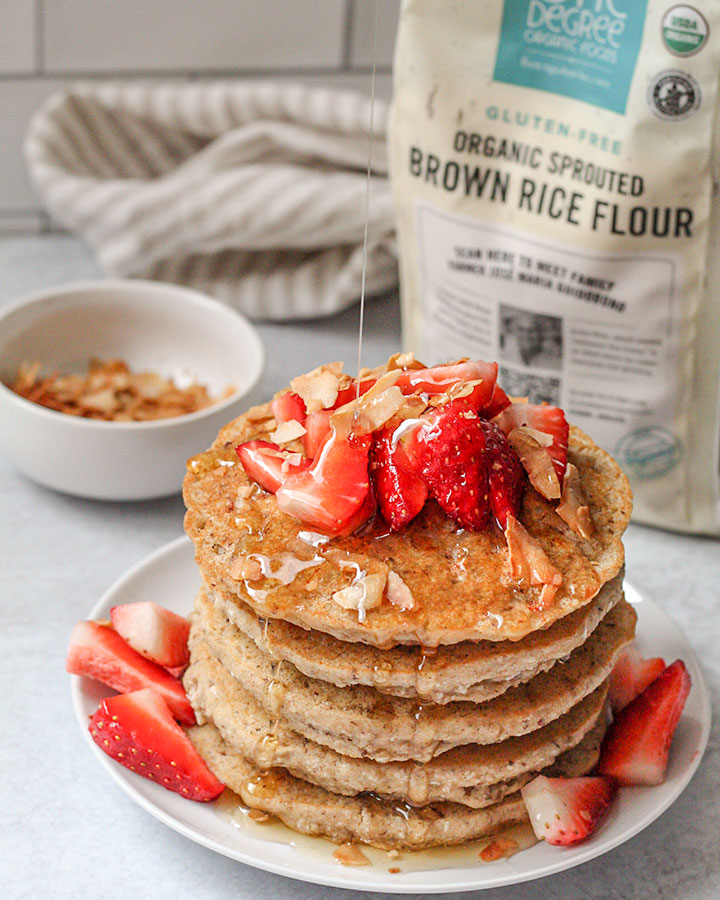
Everything we make at One Degree Organics is plant-based, certified organic, Non-GMO Project verified, and glyphosate-free. And our sprouted flours are no exception.
Each of our veganic sprouted flours are made from single whole grains you can trace all the way back to the farm to meet the farmer who grew them.
After the Canadian-grown organic wheat, spelt, and Khorasan, and dryland-farmed organic brown rice arrive in our bakery we wash our grains well before we soak and sprout them. When the grains tell us they are awake and ready, we gently dry them to preserve all the nutritional benefits enhanced by sprouting, then mill them with care to achieve the perfect silky texture for baking.
All our sprouted flours are unbleached and unbromated—because we believe organic sprouted whole grains are the only ingredient you need to make healthy flour you can feel great about baking with.
Organic Sprouted Whole Wheat Flour
Beloved by sprouted flour beginners and seasoned sprouted bakers alike, our Organic Sprouted Whole Wheat Flour is a healthy baking ingredient that deserves a place in your pantry. The go-to sprouted flour for everything from artisan bread to lemon tarts, this versatile flour makes it easy to welcome the goodness of sprouted whole grains to your favorite recipes.
Try our Organic Sprouted Whole Wheat Flour in these recipes:
- Sprouted Artisan Bread
- Vegan Cast-Iron Skillet Orange Cinnamon Twist Bread
- Sprouted Whole Wheat Coconut Lemon Tarts with Berries
- Sprouted Whole Wheat Garlic Naan
- Vegan Caramel Apple Pie
Organic Sprouted Spelt Flour
With a similar but more delicate nutty taste and slightly less gluten than whole wheat, our Organic Sprouted Spelt flour is perfect for fluffy dinner rolls, tender cookies, simple pie crusts and tarts—or even rich, chocolatey cakes baked with a bit of courage! Sprouted spelt flour lends itself well to recipes where a little tenderness and subtler flavor are called for.
Try our Organic Sprouted Spelt Flour in these recipes:
- Apple Cookies with Sprouted Spelt Flour
- Easy Fold-Over Jam Tarts with Simple Spelt Crust
- No Knead Spelt Dinner Rolls
- Spelt Flour Chocolate Bundt Cakes
- Sprouted Spelt Pumpkin Muffins with Crumble Topping
Organic Sprouted Khorasan Flour
Renowned for its sweet, nutty, and almost buttery flavor, Khorasan is a non-hybridized ancient grain variety of wheat. Our Organic Sprouted Khorasan Flour brings out the best this grain has to offer, adding richness to recipes from banana bread to cinnamon rolls.
Try our Organic Sprouted Khorasan Flour in these recipes:
- Sprouted Khorasan Orange Cardamom Raspberry Muffins
- Sprouted Khorasan Banana Chia Bread
- Sprouted Khorasan Oatmeal Chocolate Chunk Cookies
- Sprouted Khorasan Orange Cinnamon Rolls with Eggnog Icing
- Sprouted Khorasan Pancakes
Organic Sprouted Brown Rice Flour
Richly nutritious and versatile, our Organic Sprouted Brown Rice Flour brings the goodness of germinated brown rice to all your gluten-free baking.
Try our Organic Sprouted Brown Rice Flour in these recipes:
- Sprouted Brown Rice Double Chocolate Peppermint Brownies
- Gluten-free Sprouted Brown Rice Carrot Cupcakes with “Cream Cheese” Lemon Frosting
- Gluten-free Chocolate Orange Cookies
- Gluten-free Coconut Cardamom Pancakes
- Gluten-free Sprouted Brown Rice Chocolate Cupcakes with Chocolate Coconut Frosting
Whether you try one of our organic sprouted flours or stock your pantry with an assortment for all your healthy baking ambitions, you will find recipe inspiration and ingredient insights in One Degree Organics monthly newsletter. Scroll down to sign up! Or follow us on Facebook, Instagram, and Pinterest for farmer stories, news, recipes, and more.
References:
- Benincasa P., Falcinelli B., Lutts S., Stagnari F., Galieni A.. Sprouted Grains: A Comprehensive Review. Nutrients. 2019; 11(2):421. Available from: https://www.mdpi.com/2072-6643/11/2/421/htm, accessed December 4, 2019.
- Lemmens, E., Moroni, A., Pagand, J., Heiraut, P., Ritala, A., Karlen, Y., Le, K.A., Van den Broeck, H., Brouns, F., De Brier, N., Delcour, J., Impact of Cereal Seed Sprouting on Its Nutritional and Technological Properties: A Critical Review. Comprehensive Reviews in Food Science and Food Safety, 12 Dec. 2018. Available from: https://onlinelibrary.wiley.com/doi/full/10.1111/1541-4337.12414, accessed December 4, 2019.
- Richter, K., Christiansen, K., & Guo, G., Wheat Sprouting Enhances Bread Baking Performance. Cereal Foods World, 59, 231-233, 2014. Available from: https://www.semanticscholar.org/paper/Wheat-Sprouting-Enhances-Bread-Baking-Performance1-Richter-Christiansen/83253a740a714b61caadfa02417845ca03fa61ee, accessed August 14, 2020.
- Cardone, G., D’Incecco, P., Pagani, M. A., Marti, A., Sprouting improves the bread-making performance of whole wheat flour (Triticum aestivum L.). Journal of the Science of Food and Agriculture, Volume 100,6: 2453-2459, February 6, 2020. Available from: https://air.unimi.it/retrieve/handle/2434/727156/1450426/Cardone%20et%20al.%202020_Sprouting%20improves%20the%20bread-making%20performance%20of%20whole%20wheat%20flour_pre-print.pdf, accessed September 27, 2021.
- Poudel, R., Finnie, S., & Rose, D. J., Effects of wheat kernel germination time and drying temperature on compositional and end-use properties of the resulting whole wheat flour. Journal of Cereal Science, Volume 86, March 2019 p 33 – 40. Available from https://www.sciencedirect.com/science/article/abs/pii/S0733521018306994?via%3Dihub, accessed September 27, 2021.
- Dziki, D., Gawlik-Dziki, U., Processing of Germinated Grains. In Sprouted Grains: Nutritional Value, Production, and Applications (pp. 69 – 90). AACC International via Elsevier, 2019. https://doi.org/10.1016/B978-0-12-811525-1.00006-3, accessed August 11, 2020.
- Ding, J., Feng, H., Controlled germination for enhancing the nutritional value of sprouted grains. In Sprouted Grains: Nutritional Value, Production, and Applications (pp. 91–105). AACC International via Elsevier, 2019. https://doi.org/10.1016/B978-0-12-811525-1.00006-3, accessed August 11, 2020.
- Finnie, S., Brovelli, V., & Nelson, D., Sprouted grains as a food ingredient. In Sprouted Grains: Nutritional Value, Production, and Applications (pp. 113–142). AACC International via Elsevier, 2019. https://doi.org/10.1016/B978-0-12-811525-1.00006-3, accessed August 11, 2020.
